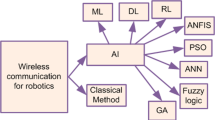Abstract
One of the key points to make robot a robust and interactive communicator is enabling robot to recognize user’s attention behavior and transit among communication situations, so that human and robot can be involved into shared activity. Four communication situations are defined to describe typical situations of interactive human-robot communication. The robot can not only open and close communication, but also adapt to user’s behavior passively or actively. We proposed a two-layered architecture of robot system. Implementation of listener robot partly proved effectiveness of the proposal approach.
Preview
Unable to display preview. Download preview PDF.
Similar content being viewed by others
References
Sinder, C., Lee, C., Kidd, C.: Engagement During Dialogues with Robots. In: Proc. of Symposium on Informatics for Supporting Social Intelligence and Interaction, SSAISB 2005 Convention, Hatfield, UK, pp. 27–31 (2005)
Hatakeyama, M.: Human-Robot Interaction based on Interaction Schema (in Japanese), Master Thesis, University of Tokyo, Japan (2004)
Hatakeyama, M., Hatada, T., Nishida, T.: Robot and Human Communication Using Bodily Expressions. In: SICE Annual Conference 2003, TAI-11-1, Japan (2003)
Tajima, T.: Human-Agent Communication of Tacit Intention by Symbol Mapping and Entrainment (in Japanese), Master’s thesis, Graduate School of Information Science and Technology, The University of Tokyo, Japan (2004)
Okamoto, M., Nakano, I.Y., Nishida, T.: Toward Enhancing User Involvement Via Empathy Channel in Human-Computer Interface Design. In: Bolc, L., Michalewicz, Z., Nishida, T. (eds.) IMTCI 2004. LNCS (LNAI), vol. 3490, pp. 111–121. Springer, Heidelberg (2005)
Ogasawara, Y.: A Listener Robot Capable of Establishing Joint Attention Based on the Redundancy of Nonverbal Behaviors (in Japanese). Master’s thesis, Graduate School of Information Science and Technology, The University of Tokyo, Japan (2005)
Author information
Authors and Affiliations
Editor information
Editors and Affiliations
Rights and permissions
Copyright information
© 2005 Springer-Verlag Berlin Heidelberg
About this paper
Cite this paper
Ogasawara, Y., Okamoto, M., Nakano, Y.I., Xu, Y., Nishida, T. (2005). How to Make Robot a Robust and Interactive Communicator. In: Khosla, R., Howlett, R.J., Jain, L.C. (eds) Knowledge-Based Intelligent Information and Engineering Systems. KES 2005. Lecture Notes in Computer Science(), vol 3683. Springer, Berlin, Heidelberg. https://doi.org/10.1007/11553939_42
Download citation
DOI: https://doi.org/10.1007/11553939_42
Publisher Name: Springer, Berlin, Heidelberg
Print ISBN: 978-3-540-28896-1
Online ISBN: 978-3-540-31990-0
eBook Packages: Computer ScienceComputer Science (R0)




